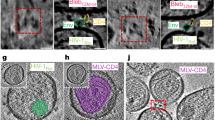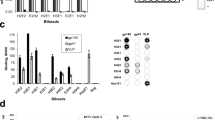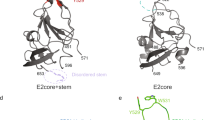Abstract
THE envelope glycoprotein (gp120/41) of the human immunodeficiency virus (HIV-1)1,2 attaches the virus to the cellular CD4 receptor and mediates virus entry into the cytoplasm3–5. In addition to being required for formation of infectious HIV, expression of gp120/41 at the plasma membrane causes the cytopathic fusion of cells carrying the CD4 antigen6–8. The expression of gp120/41 is therefore an ideal target for therapeutic strategies designed to combat AIDS. Here we show that expression of a soluble CD4 molecule, mutated to contain a specific retention signal for the endoplasmic reticulum, blocks secretion of gp120 and surface expression of gp120/41, but does not interfere with transport of wild-type CD4. By blocking transport of the HIV glycoprotein, this retained CD4 molecule prevents the fusion of CD4 cells that is normally caused by the HIV glycoprotein. Expression of the retained CD4 molecule in human T cells might therefore be useful in the intracellular immunization procedure suggested by Baltimore9.
This is a preview of subscription content, access via your institution
Access options
Subscribe to this journal
Receive 51 print issues and online access
$199.00 per year
only $3.90 per issue
Buy this article
- Purchase on Springer Link
- Instant access to full article PDF
Prices may be subject to local taxes which are calculated during checkout
Similar content being viewed by others
References
Gallo, R. C. et al. Science 224, 500–503 (1984).
Barre-Sinoussi, F. et al. Science 220, 868–871 (1983).
Sattentau, Q. J. & Weiss, R. A. Cell 52, 631–633 (1988).
Maddon, P. J. et al. Cell 42, 93–104 (1985).
Maddon, P. J. et al. Cell 47, 333–348 (1986).
Lifson, J. D., Reyes, G. R., McGrath, M. S., Stein, B. S. & Engelman, E. G. Science 232, 1123–1127 (1986).
Lifson, J. D. et al. Nature 323, 725–728 (1986).
Sodroski, J., Goh, W. C., Rosen, C., Campbell, K. & Haseltine, W. A. Nature 322, 470–474 (1986).
Baltimore, D. Nature 335, 395–396 (1988).
Hoxie, J. A. et al. Science 234, 1123–1127 (1986).
Kawamura, I. et al. J. Virol. 63, 3748–3754 (1989).
Willey, R. L., Bonifacino, J. S., Potts, B. J., Martin, M. A. & Klausner, R. D. Proc. natn. Acad. Sci. U.S.A. 85, 9580–9584 (1988).
Munro, S. & Pelham, H. R. B. Cell 48, 899–907 (1987).
Fuerst, T. R., Niles, E. G., Studier, F. W. & Moss, B. Proc. natn. Acad. Sci. U.S.A. 83, 8122–8126 (1986).
Iarentino, A. L. & Maley, F. J. biol. Chem. 249, 811–817 (1974).
Kornfeld, R. & Kornfeld, S. A. Rev. Biochem. 54, 631–664 (1985).
Dunphy, W. G. & Rothman, J. E. Cell 42, 13–21 (1985).
Smith, D. H. et al. Science 238, 1704–1707 (1987).
Fisher, R. A. et al. Nature 331, 76–78 (1988).
Hussey, R. E. et al. Nature 331, 78–81 (1988).
Deen, K. C. et al. Nature 331, 82–84 (1988).
Traunecker, A., Luke, W. & Karjalainen, K. Nature 331, 84–86 (1988).
Malim, M. H., Bohnlein, S., Hauber, J. & Cullen, B. R. Cell 58, 205–214 (1989).
Green, G., Ishino, M. & Loewenstein, P. M. Cell 58, 215–223 (1989).
Trono, D., Feinberg, M. B. & Baltimore, D. Cell 59, 113–120 (1989).
Kunkel, T. A. Proc. natn. Acad. Sci. U.S.A. 82, 488–492 (1985).
Shaw, A. S. et al. Cell 59, 627–636 (1989).
Sanger, F., Nicklen, S. & Coulson, A. R. Proc. natn. Acad. Sci. U.S.A. 74, 5463–5467 (1977).
Whitt, M., Chong, L. & Rose, J. K. J. Virol. 63, 3569–3578 (1989).
Feigner, P. L. et al. Proc. natn. Acad. Sci. U.S.A. 84, 7413–7417 (1987).
Rose, J. K. & Bergman, J. E. Cell 34, 513–524 (1983).
Laemmli, U. K. Nature 227, 680–684 (1970).
Ratner, L. et al. Nature 313, 277–284 (1985).
Author information
Authors and Affiliations
Rights and permissions
About this article
Cite this article
Buonocore, L., Rose, J. Prevention of HIV-1 glycoprotein transport by soluble CD4 retained in the endoplasmic reticulum. Nature 345, 625–628 (1990). https://doi.org/10.1038/345625a0
Received:
Accepted:
Issue Date:
DOI: https://doi.org/10.1038/345625a0
This article is cited by
-
Lessons in Détente or know thy host: The immunomodulatory gene products of myxoma virus
Journal of Biosciences (2003)
Comments
By submitting a comment you agree to abide by our Terms and Community Guidelines. If you find something abusive or that does not comply with our terms or guidelines please flag it as inappropriate.



